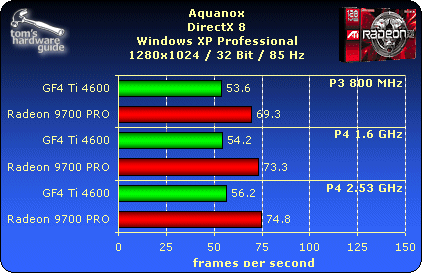ATi Radeon 9700 PRO - Pretender To The Throne
CPU Scaling
Many benchmark results look very impressive but do little to help the prospective consumer reach an informed decision. New graphics cards should be tested on the fastest available hardware to demonstrate their full potential. Yet how many buyers actually have the same hardware at home that hardware testers have at their disposal? Reading a review such as this, many may find themselves wondering which subsystem really needs to be upgraded the most. CPU? Motherboard? Video card?
To help you make an informed decision, we have also conducted a few tests on slower systems, namely a Pentium 4 1600 MHz and a Pentium 3 800 MHz system.
Keep in mind, though, that we can only make very broad statements here. If a game is mostly CPU-dependent, then even the fastest video card won't be able to speed up your system. Conversely, if a game requires a lot of rendering power, then a high-end card may make sense even in a slower system - especially if you're planning to use FSAA and/ or anisotropic filtering.
Here is a list of several games, each with its own requirements:
Aquanox
Aquanox's 3D engine is quite independent of CPU power. It does rely very heavily on the video card's rendering performance, though. At 1280x1024, a P3 system produced almost the same results as a P4 2.53! This phenomenon can be observed on both the GeForce4 Ti and the Radeon 9700 PRO.
Get Tom's Hardware's best news and in-depth reviews, straight to your inbox.
Current page: CPU Scaling
Prev Page 3D Mark 2001 SE - FSAA + Aniso - Dragothic High Next Page Quake 3

